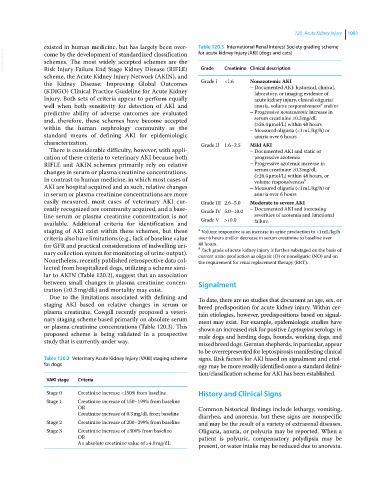Page 1153 - Clinical Small Animal Internal Medicine
P. 1153
120 Acute Kidney Injury 1091
existed in human medicine, but has largely been over- Table 120.3 International Renal Interest Society grading scheme
VetBooks.ir come by the development of standardized classification Grade Creatinine Clinical description
for acute kidney injury (AKI) (dogs and cats)
schemes. The most widely accepted schemes are the
Risk Injury Failure End Stage Kidney Disease (RIFLE)
scheme, the Acute Kidney Injury Network (AKIN), and
the Kidney Disease: Improving Global Outcomes Grade I <1.6 Nonazotemic AKI
– Documented AKI: historical, clinical,
(KDIGO) Clinical Practice Guideline for Acute Kidney laboratory, or imaging evidence of
Injury. Both sets of criteria appear to perform equally acute kidney injury, clinical oliguria/
a
well when both sensitivity for detection of AKI and anuria, volume responsiveness and/or
predictive ability of adverse outcomes are evaluated – Progressive nonazotemic increase in
and, therefore, these schemes have become accepted serum creatinine ≥0.3 mg/dL
(≥26.4 μmol/L) within 48 hours
within the human nephrology community as the – Measured oliguria (<1 mL/kg/h) or
standard means of defining AKI for epidemiologic anuria over 6 hours
characterization. Grade II 1.6–2.5 Mild AKI
There is considerable difficulty, however, with appli- – Documented AKI and static or
cation of these criteria to veterinary AKI because both progressive azotemia
RIFLE and AKIN schemes primarily rely on relative – Progressive azotemic increase in
changes in serum or plasma creatinine concentrations. serum creatinine ≥0.3 mg/dL
(≥26.4 μmol/L) within 48 hours, or
In contrast to human medicine, in which most cases of volume responsiveness b
AKI are hospital acquired and as such, relative changes – Measured oliguria (<1 mL/kg/h) or
in serum or plasma creatinine concentrations are more anuria over 6 hours
easily measured, most cases of veterinary AKI cur- Grade III 2.6–5.0 Moderate to severe AKI
rently recognized are community acquired, and a base- Grade IV 5.0–10.0 – Documented AKI and increasing
line serum or plasma creatinine concentration is not Grade V >10.0 severities of azotemia and functional
available. Additional criteria for identification and failure
staging of AKI exist within these schemes, but these a Volume responsive is an increase in urine production to >1 mL/kg/h
criteria also have limitations (e.g., lack of baseline value over 6 hours and/or decrease in serum creatinine to baseline over
for GFR and practical considerations of indwelling uri- 48 hours.
b
Each grade of acute kidney injury is further substaged on the basis of
nary collection system for monitoring of urine output). current urine production as oliguric (O) or nonoliguric (NO) and on
Nonetheless, recently published retrospective data col- the requirement for renal replacement therapy (RRT).
lected from hospitalized dogs, utilizing a scheme simi-
lar to AKIN (Table 120.2), suggest that an association
between small changes in plasma creatinine concen- Signalment
tration (≥0.3 mg/dL) and mortality may exist.
Due to the limitations associated with defining and To date, there are no studies that document an age, sex, or
staging AKI based on relative changes in serum or breed predisposition for acute kidney injury. Within cer-
plasma creatinine, Cowgill recently proposed a veteri- tain etiologies, however, predispositions based on signal-
nary staging scheme based primarily on absolute serum ment may exist. For example, epidemiologic studies have
or plasma creatinine concentrations (Table 120.3). This shown an increased risk for positive Leptospira serology in
proposed scheme is being validated in a prospective male dogs and herding dogs, hounds, working dogs, and
study that is currently under way. mixed breed dogs. German shepherds, in particular, appear
to be overrepresented for leptospirosis manifesting clinical
Table 120.2 Veterinary Acute Kidney Injury (VAKI) staging scheme signs. Risk factors for AKI based on signalment and etiol-
for dogs ogy may be more readily identified once a standard defini-
tion/classification scheme for AKI has been established.
VAKI stage Criteria
Stage 0 Creatinine increase <150% from baseline History and Clinical Signs
Stage 1 Creatinine increase of 150–199% from baseline
OR Common historical findings include lethargy, vomiting,
Creatinine increase of 0.3 mg/dL from baseline
diarrhea, and anorexia, but these signs are nonspecific
Stage 2 Creatinine increase of 200–299% from baseline and may be the result of a variety of extrarenal diseases.
Stage 3 Creatinine increase of ≥300% from baseline Oliguria, anuria, or polyuria may be reported. When a
OR patient is polyuric, compensatory polydipsia may be
An absolute creatinine value of >4.0 mg/dL
present, or water intake may be reduced due to anorexia.

